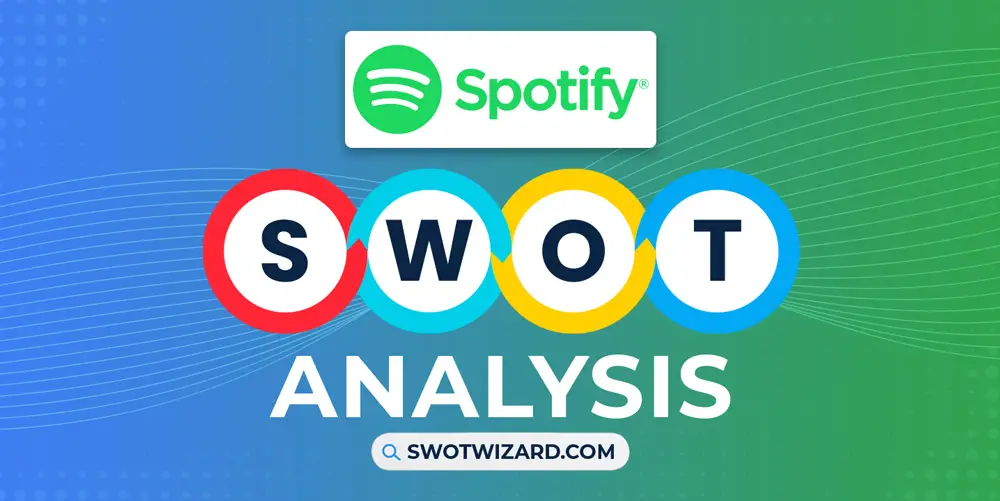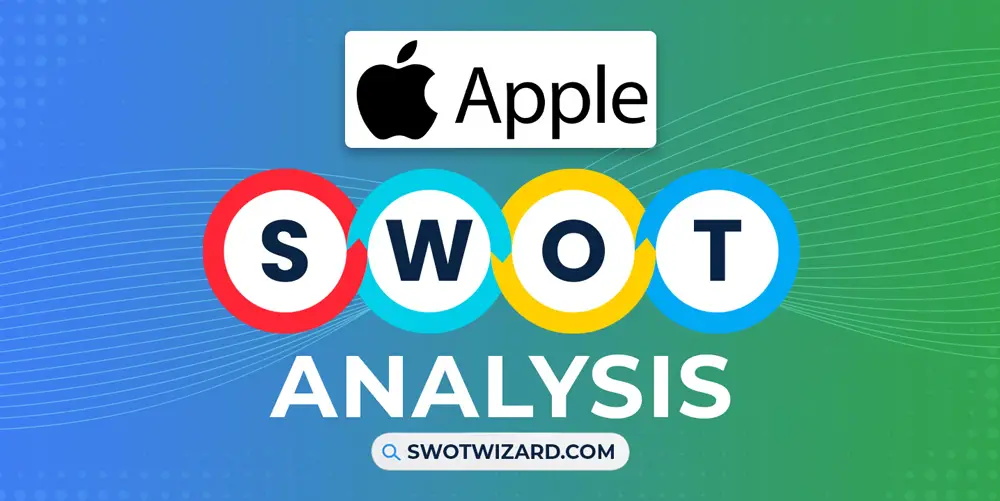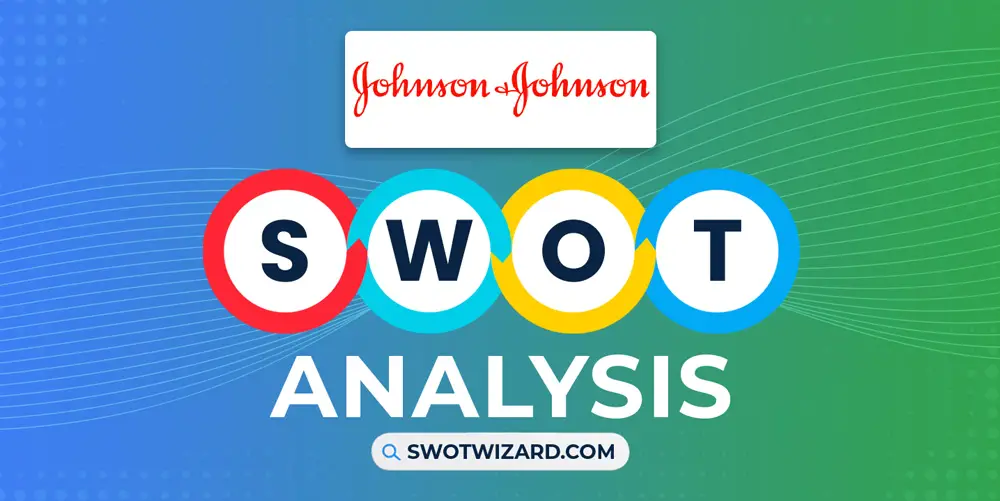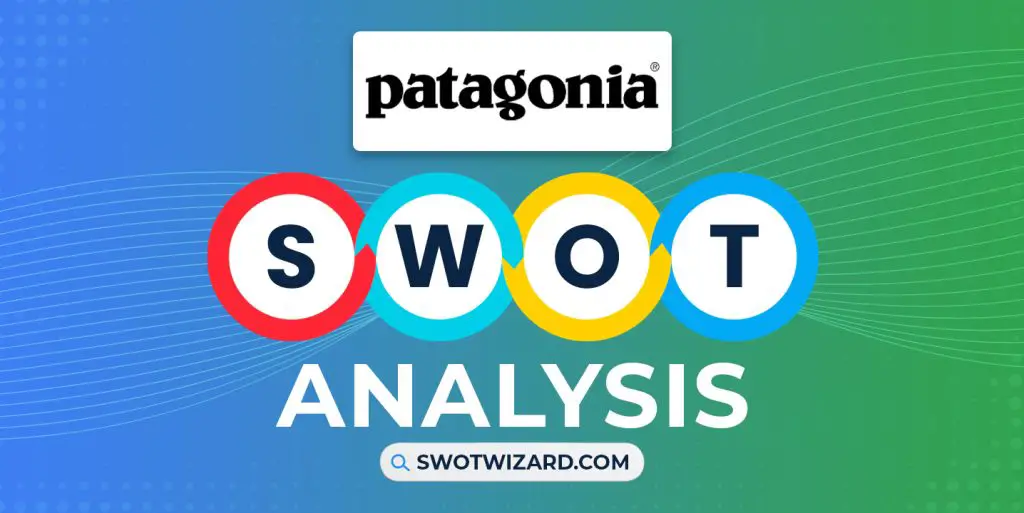Spotify ranks as the world’s 942nd company in terms of market cap. With a market cap of $17.71 billion and over 400 million users, it’s a textbook example of the success of the freemium and subscription business models. Let’s go over the Spotify SWOT analysis to understand the reasons for its success and its potential.
Spotify: Company Overview
| Company | Spotify |
| Industry | Audio Streaming |
| Founded | 23 April, 2006 |
| Founder | Daniel Ek, Martin Lorentzon |
| CEO | Daniel Ek |
| Headquarter | Stockholm, Sweden |
| No. of Employees | 6,617+ |
| Annual Revenue | €9.668 billion (FY 2021) |
| Website | spotify.com |
After witnessing the success of Napster, and the rise of Kazza, Co-founder Daniel Ek thought of Spotify in 2002. After deciding to go ahead with the company in 2006, Daniel Ek and Martin Lorentzon spent 2 years acquiring licenses and finally launched Spotify in 2008. In 2009, it launched in the US and instantly won over 1 million players.
In 2022, Spotify will have a TTM revenue of $11.99 billion, and a stock price of $91.75. The company has over 404 million active monthly listeners and over 200,000 professional artists. It has over 80 million tracks, including 4.7 million podcasts for users to browse.
Product & Services of Spotify
Music Streaming
Spotify Competitors
Apple Music | Amazon Music | YouTube Music | Pandora | SoundCloud | Pandora | Tencent Music
Did You Know?
Spotify got its name because Co-Founder Daniel Ek misheard the original name. It later became Spotify by combining spot and identify.
Strengths – Spotify SWOT Analysis
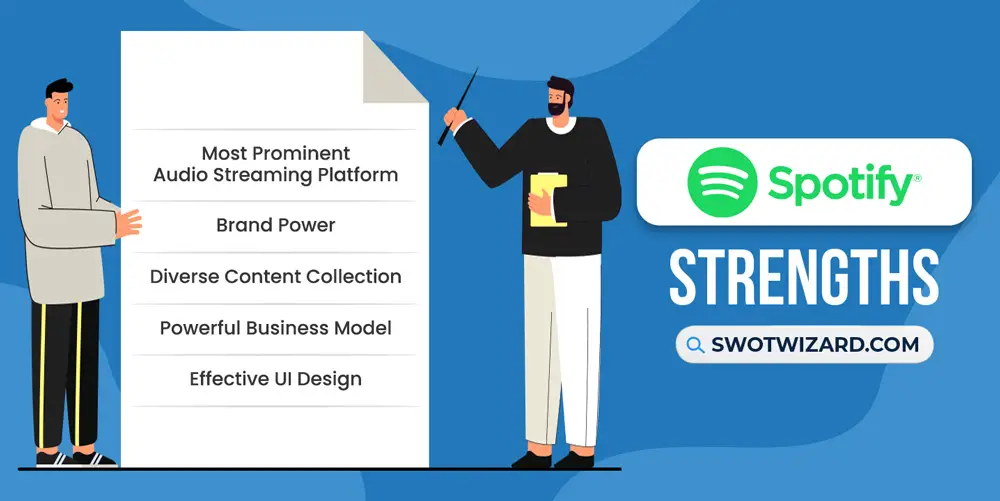
Most Prominent Audio Streaming Platform: Spotify is arguably the most prominent audio streaming platform. It has the highest saturation of all its competitors, thanks to having a baked-in desktop application on Windows, an app on both Android and iOS, and being usable in all other operating systems such as Mac, Fire OS, and Linux. It is also the most used platform to embed audio content in social media.
Brand Power: Spotify is recognized as the most viable platform for every artist for profit. The streaming service had over 404 million monthly users in 2022, and over 181 million of them were paid users. Its visibility, popularity, ease of use, and security are attractive points for both starting and prominent artists. So, Spotify’s brand image draws content makers without a need for marketing.
Diverse Content Collection: Spotify offers a large variety of content, from every genre of music to podcasts and even video content. Because the platform is a lot more liberal than other content-based platforms, such as YouTube, it also contains content that is explicit and diverse. Due to its wide collection, users flock to the platform to find the content they want to hear unfiltered.
Powerful Business Model: Spotify’s subscription-based model is the most dominant, future-proof, and profitable way to push content. The subscription economy is projected to reach $1.5 trillion by 2025, and 75% of adults think subscriptions will replace ownership. Spotify users pay a recurring fee of $10 monthly to have full access, but they never own or download any content. The company may not get a large upfront payment from the users, but this model ensures that it will have a continuous revenue stream, raise prices with inflation, and build an ecosystem.
Effective UI Design: Spotify’s user interface has always prioritized simplicity and relevance. In 2013, Spotify pushed the Swedish concept of Lagom, pushing content first, making the users feel lively, appreciative, and authentic. In 2020, it reworked its UI to prioritize audio content such as podcasts, customizing for every user, and dynamic shifts from emotion to logic, unity, and consistency. Even with the design shifts in the UI, Spotify has always been simple to use, simple to understand, and simple to explore.
Weaknesses – Spotify SWOT Analysis
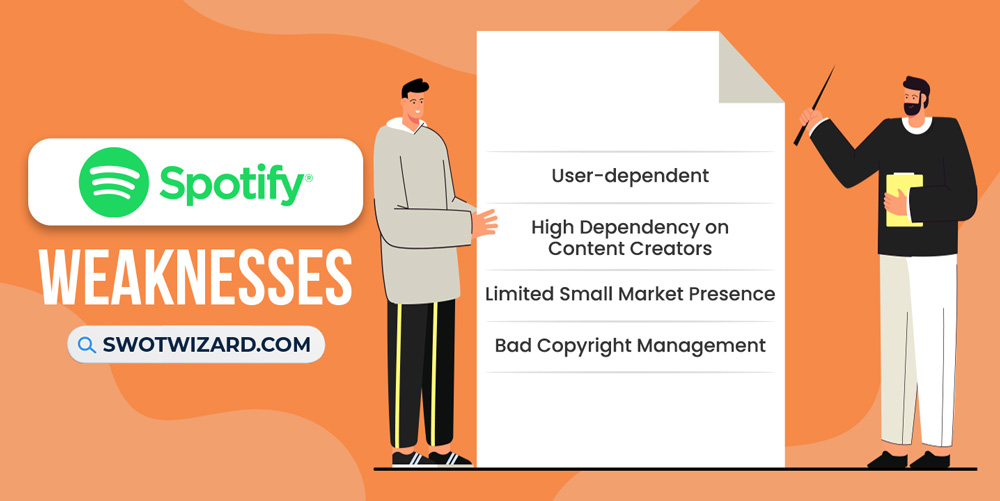
User-dependent: Spotify’s business is more dependent on its user base due to its business model. While a 4.8% quarterly customer churn rate would not affect most other businesses, it can lose Spotify millions in revenue. In 2018, Spotify’s monthly APRU was $5.4, the cost of revenue per user was $3.9, and the gross profit per user was $1.4. The lifetime value of a customer was $31.1, and cancellations can have a harsh impact.
High Dependency on Content Creators: Spotify’s business model requires the company to constantly push out new content for value. To provide value for its subscription fee, Spotify needs a substantial amount of creators to provide routine updates. Each month, 1,800,000 songs are uploaded on Spotify, and even that is not enough. The company has to rely on podcasts to draw in new customers and retain old ones.
Limited Small Market Presence: Although Spotify has entered smaller music markets, it has failed to grab the attention of consumers. Spotify has only 782 listeners in Bhutan, 2695 in Qatar, 4268 in Kuwait, 5185 in New Zealand, and 5975 in Singapore. By July 2021, New Zealand only downloaded the app 43,162 times, a nearly 50% plunge from January 2021. These numbers indicate that Spotify struggles to keep up with trends, understand consumers, and push proper content in smaller markets.
Bad Copyright Management: Spotify has been known to struggle with copyright management for years. The company has been accused and proven to feature over 10,000 songs without proper licensing on its website. It has also been known to copyright strike users for music that they own or have received permission to use. Its bad copyright management has caused many artists to lose their image and profit without any valid reason.
Opportunities – Spotify SWOT Analysis
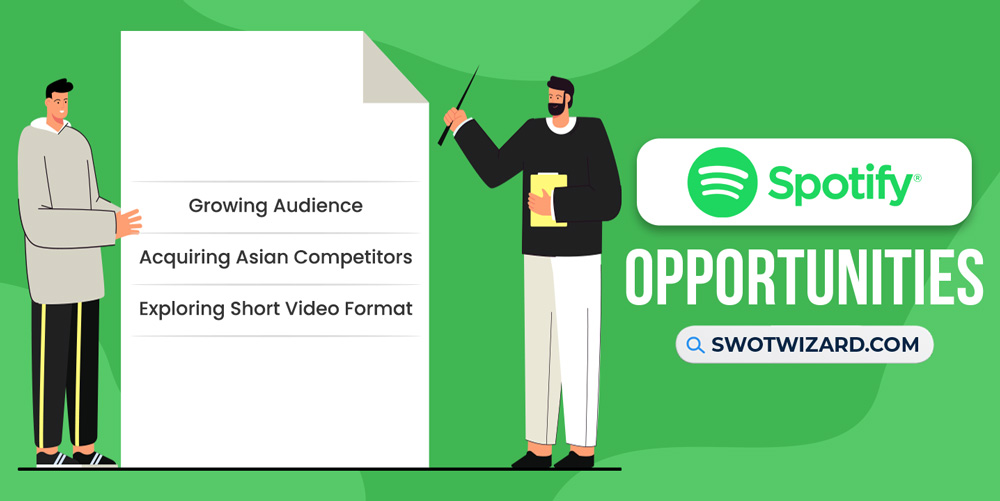
Growing Audience: Thanks to social media, a lot of ignored or less famous artists have gotten very popular, and older songs have begun to draw attention. Typically, users visit Spotify after hearing a song featured on a YouTube short or TikTok to find it. Spotify can push these songs on a recommended tab to attract consumers.
Acquiring Asian Competitors: Spotify’s Asian competitors, such as Melon, QQ Music, Joox, KKBox, JioSaavn, and Genie Music specialize in K-pop, J-pop, Hindi, and other Asian music formats. It would take years to build up a library that matches all these platforms and market it. However, Spotify can easily acquire them and access a large consumer base.
Exploring Short Video Format: Instead of long-form, Spotify can try short-form video content for artist exposure and marketing. Artists and users can upload short videos as channel introductions and market their podcasts and albums. Spotify can make use of the virality of short video content and gain more users.
Threats – Spotify SWOT Analysis
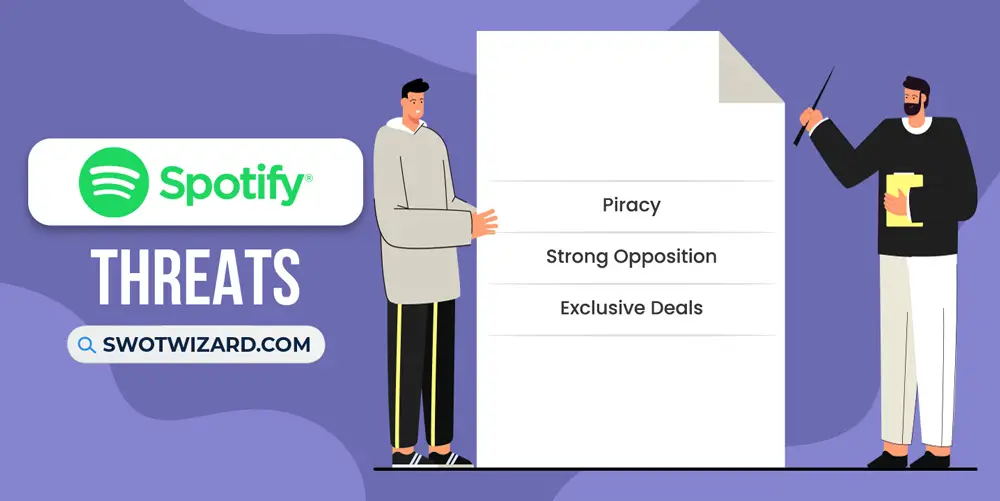
Piracy: Spotify cannot prevent screen recorders, sound recorders, and music software from recording its audio content and saving it. Many free users can get annoyed by adverts or like to own the music they hear. They can simply download the entire discography of an artist from torrents and leave Spotify without revenue.
Strong Opposition: Apple Music, Deezer, and Tidal are powerful global music platforms with large user bases. Apple Music had 78 million users in June 2021, and the number has grown ever since. Asian competitors such as JioSaavn, and QQ Music have unique music libraries that the company cannot compete with. As most users don’t like subscribing to multiple audio platforms, Spotify is at risk of being taken down by the combined pressure.
Exclusive Deals: Other platforms, such as Tidal, have signed exclusive deals with artists such as Jay-Z, Rihanna, Drake, Beyonce, and more. These artists either exclusively publish their content on the contracted platform or late release the content for the other platform. In both cases, Spotify is at risk of losing significant revenue from fans of these artists abandoning its platform.
[Bonus Infographic] SWOT Analysis of Spotify
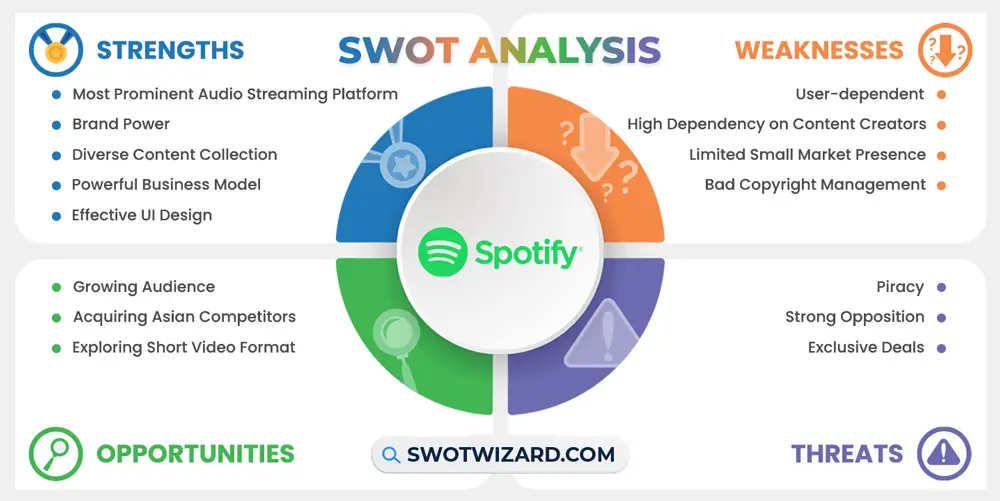
Recommendations for Spotify
No single competitor can take Spotify down, but compound pressure from every competitor will. So, Spotify should consider these suggestions to ensure its continued growth.
- Spotify should include an artist burnout program or an on-leave program. This will allow the company to understand its monthly earnings better and allow the artists and podcasters to plan their absence without harming their channels.
- Spotify should make its platform new and artist-friendly. Many new artists flock to Soundcloud, especially hip-hop artists. By including experimental and new styles of music on the platform, it can bring in a large number of users.
- The company should consider offering selective subscription packages. Users can exclude what they don’t like and save money. Many music fans will want a cheap way to listen to artists that they love.
- Instead of showing ads in the middle of a song, Spotify can put them at the end of songs and make them unskippable. While ads will always annoy some users, this format will cause fewer issues.
- Spotify can offer users the ability to lease entire albums or discographies for years or months. This will stop users from opting for pirated music because they want ownership.
Frequently Asked Questions (FAQs)
Can you use Spotify offline?
Spotify offers offline playing options, but only for premium users and native apps.
Which audio format does Spotify prefer for music?
Spotify recommends FLAC or WAV over other formats for preserving the quality of music.
Final Words on Spotify SWOT Analysis
Spotify stands in an envious position in the music industry, but the industry doesn’t share its consumer base. To continue its growth, it now has to absorb its competitors’ users. The company can achieve this through marketing tactics, acquisitions, and a larger library.
References
- Wikipedia contributors. (n.d.). Spotify. Wikipedia.
- Charlotte Götting, M. (2021, January 8). Quarterly subscriber churn rate of Spotify worldwide from 2nd quarter 2018 to 4th quarter 2019. Statista.
- Spotify (SPOT) – Revenue. (n.d.). CompaniesMarketCap.
- Aswad, J., & Halperin, S. (2021, March 4). Beyonce, Rihanna, Kanye: How Much Do Tidal’s Artist Partners Stand to Make? Variety.
- Hendelmann, V. (n.d.). The Subscription Based Business Model – A Complete Guide. Productmint.
- Hughes, C. (2023, January 3). Spotify app monthly downloads in New Zealand from January 2019 to July 2021. Statista.
- The History of Spotify. (n.d.). Mental Itch.
- Ogles, J. (2017, March 23). No One Can Explain Why YouTube Bans Some LGBT Content. Advocate.
- Pendlebury, T. (2022, December 8). Best Music Streaming Service of 2023. CNET.
- Perez, S. (2018, December 20). Spotify settles the $1.6B copyright lawsuit filed by music publisher Wixen. TechCrunch.
- Ruby, D. (2022, December 30). Spotify Stats 2023 (Facts & Data Listed). Demand Sage.
- Shah, A. (2019, March 6). How much does a subscriber worth to Spotify? Medium.
- 18 Subscription Economy Statistics To Stay One Step Ahead. (n.d.). Soocial.
- Spotify Premium. (n.d.). Spotify.
- About. (n.d.). Spotify.
- Windows Download. (n.d.). Spotify.
- Explicit content. (n.d.). Spotify.
- Introducing Spotify’s New Design Principles. (2020, June). Spotify Design.
- Tiaz, J. (2020, May 31). 25 Facts About Spotify. The Music Streaming Service Facts. Tech25.
- van der Sar, E. (2022, July 8). Bogus Takedowns Frustrate Musicians and Wipe Music From Spotify. TorrentFreak.
- Vultaggio, M. (2022, August 26). How Many Artists Are On Spotify In 2022? Answered By Spotify! Best Friends Club.
- Wise, J. (2022, July 24). How Many People Use Spotify in 2023? (Usage Statistics). EarthWeb.
- Spotify Users by Country 2022. (2022, September 25). World Populace.

